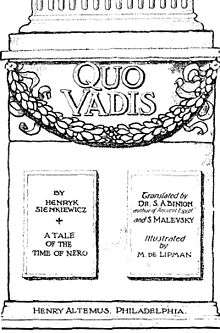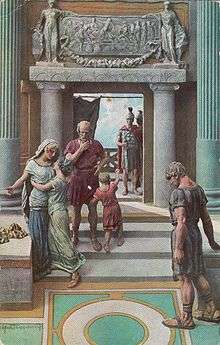Quo Vadis (novel)
 First American edition title page | |
| Author | Henryk Sienkiewicz |
|---|---|
| Original title | Quo vadis. Powieść z czasów Nerona |
| Translator |
Jeremiah Curtin W. S. Kuniczak |
| Country | Poland |
| Language | Polish |
| Genre | Historical novel |
| Publisher | Polish dailies (in serial) and Little, Brown (Eng. trans. book form) |
Publication date | 1895 |
| Media type | Print (Newspaper, Hardback and Paperback) |


Quo Vadis: A Narrative of the Time of Nero, commonly known as Quo Vadis, is a historical novel written by Henryk Sienkiewicz in Polish.[1] "Quo vadis Domine" is Latin for "Where are you going, Lord?" and alludes to the apocryphal Acts of Peter, in which Peter flees Rome but on his way meets Jesus and asks him why he is going to Rome. Jesus says, "I am going back to be crucified again", which makes Peter go back to Rome and accept martyrdom.
The novel Quo Vadis tells of a love that develops between a young Christian woman, Ligia (or Lygia), and Marcus Vinicius, a Roman patrician. It takes place in the city of Rome under the rule of emperor Nero, circa AD 64.
Sienkiewicz studied the Roman Empire extensively prior to writing the novel, with the aim of getting historical details correct. Consequently, several historical figures appear in the book. As a whole, the novel carries an outspoken pro-Christian message.
Published in installments in three Polish dailies in 1895, it came out in book form in 1896 and has since been translated into more than 50 languages. This novel contributed to Sienkiewicz's Nobel Prize for literature in 1905.
Several movies have been based on Quo Vadis including two Italian silent films—Quo Vadis (1913 film) and Quo Vadis (1924 film)—a Hollywood production—Quo Vadis (1951 film)—and an adaptation by Jerzy Kawalerowicz: Quo Vadis (2001 film).
Characters in Quo Vadis
- Marcus Vinicius (fictitious son of the historical Marcus Vinicius), a military tribune and Roman patrician who recently returned to Rome. On arrival he meets and falls in love with Ligia. He seeks the counsel of his uncle Petronius to find a way to possess her.
- Calina (fictitious), usually known as Ligia (Lygia in some translations), the daughter of a deceased king of the Ligians, a barbarian tribe (hence her nickname). Ligia is technically a hostage of the Senate and people of Rome, and was forgotten years ago by her own people. A great beauty, she has converted to Christianity, but her religion is originally unknown to Marcus.
- Gaius Petronius (historical), titled the "arbiter of elegance," former governor of Bithynia. Petronius is a member of Nero's court who uses his wit to flatter and mock him at the same time. He is loved by the Roman mob for his liberal attitudes. Somewhat amoral and a bit lazy, he tries to help his nephew, but his cunning plan is thwarted by Ligia's Christian friends.
- Eunice (fictitious), household slave of Petronius. Eunice is a beautiful young Greek woman who has fallen in love with her master, although he is initially unaware of her devotion.
- Chilon Chilonides (fictitious), a charlatan and a private investigator. He is hired by Marcus to find Ligia. This character is severely reduced in the 1951 film and the 1985 miniseries, but in the novel itself, as well as in the Polish miniseries of 2001, Chilon is a major figure as doublecrossing traitor. His end is clearly inspired by Saint Dismas.
- Nero (historical), Emperor of Rome, portrayed as incompetent, petty, cruel, and subject to manipulation by his courtiers. He listens most intently to flatterers and fools.
- Tigellinus (historical), the prefect of the feared Praetorian Guard. He is a rival of Petronius for Nero's favour, and he incites Nero into committing acts of great cruelty.
- Poppaea Sabina (historical), the wife of Nero. She passionately envies and hates Ligia.
- Acte (historical), an Imperial slave and former mistress of Nero. Nero has grown tired of her and now mostly ignores her, but she still loves him. She studies the Christian faith, but does not consider herself worthy of full conversion. In the 1951 film, it is she who helps Nero commit suicide.
- Aulus Plautius (historical), a respected retired Roman general who commanded the invasion of Britain. Aulus seems unaware (or simply unwilling to know) that Pomponia, his wife, and Ligia, his adoptive daughter, profess the Christian religion.
- Pomponia Graecina (historical), a Christian convert. Dignified and much respected, Pomponia and Aulus are Ligia's adoptive parents, but they are unable to legalize her status. According to Roman law Ligia is still a hostage of the Roman state (i.e., of the Emperor), but she is cared for by the elderly couple.
- Ursus (fictitious), the bodyguard of Ligia. As a fellow tribesman, he served her late mother, and he is strongly devoted to Ligia. As a Christian, Ursus struggles to follow the religion's peaceful teachings, given his great strength and barbarian mindset.
- Saint Peter (historical), a weary and aged man with the task of preaching Christ's message. He is amazed by the power of Rome and the vices of Emperor Nero, whom he names the Beast. Sometimes Peter doubts that he will be able to plant and protect the "good seed" of Christianity.
- Saint Paul (historical) takes a personal interest in converting Marcus.
- Crispus (fictitious), a Christian zealot who verges on fanaticism.
Historical events
Sienkiewicz alludes to several historical events and merges them in his novel, but some of them are of doubtful authenticity.
- In AD 57, Pomponia was indeed charged with practising a "foreign superstition", usually understood to mean conversion to Christianity. Nevertheless, the religion itself is not clearly identified. According to ancient Roman tradition she was tried in a family court by her own husband Aulus (the pater familias), to be subsequently acquitted. However, inscriptions in the catacombs of Saint Callistus in Rome suggest that members of Graecina's family were indeed Christians.
- The rumor that Vespasian fell asleep during a song sung by Nero is recorded by Suetonius in the Lives of the Twelve Caesars.
- The death of Claudia Augusta, sole child of Nero, in AD 63.
- The Great Fire of Rome in AD 64, which in the novel is started by orders of Nero. There is no hard evidence to support this, and fires were very common in Rome at the time. In Chapter 50, senior Jewish community leaders advise Nero to blame the fires on Christians; there is no historical record of this, either. The fire opens up space in the city for Nero's palatial complex, a massive villa with lush artificial landscapes and a 30-meter-tall sculpture of the emperor, as well as an ambitious urban planning program involving the creation of buildings decorated with ornate porticos and the widening of the streets (a redesign which is not implemented until after Nero's death).
- The suicide of Petronius is clearly based on the account of Tacitus.
Similarities with Barrett play
1896 was also the year that playwright-actor-manager Wilson Barrett produced his successful play The Sign of the Cross. Although Barrett never acknowledged it, several elements in the play strongly resemble those in Quo Vadis. In both, a Roman soldier named Marcus falls in love with a Christian woman and wishes to "possess" her. (In the novel, her name is Ligia, in the play she is Mercia.) Nero, Tigellinus and Poppea are major characters in both the play and novel, and in both, Poppea lusts after Marcus. Petronius, however, does not appear in The Sign of the Cross, and the ending of the play diverges from that of Quo Vadis.
Adaptations
_01.jpg)
A successful stage version of the novel by Stanislaus Stange was produced in 1900.[2] Film versions of the novel were produced in 1901, 1912 and 1924.[3] A 1951 version directed by Mervyn LeRoy was nominated for eight Academy Awards. The novel was also the basis for a 1985 mini-series starring Klaus Maria Brandauer as Nero and a 2001 Polish mini-series directed by Jerzy Kawalerowicz. It was also comically satirized as the quintessential school play gone horribly awry in Shivering Shakespeare, a 1930 Little Rascals short by Hal Roach.
Jean Nouguès composed an opera based on the novel, to a libretto by Henri Caïn; it was premiered in 1909.[4] Feliks Nowowiejski composed an oratorio based on the novel, performed for the first time in 1907, and then his most popular work.
Ursus series (1960–1964)
Following Buddy Baer's portrayal of Ursus in the classic 1951 film Quo Vadis, Ursus was used as a superhuman Roman-era character who became the protagonist in a series of Italian adventure films made in the early 1960s.
When the "Hercules" film craze hit in 1959, Italian filmmakers were looking for other muscleman characters similar to Hercules whom they could exploit, resulting in the 9-film Ursus series listed below. Ursus was referred to as a "Son of Hercules" in two of the films when they were dubbed in English (in an attempt to cash in on the then-popular "Hercules" craze), although in the original Italian films, Ursus had no connection to Hercules whatsoever. In the English-dubbed version of one Ursus film (retitled Hercules, Prisoner of Evil), Ursus was actually referred to throughout the entire film as "Hercules".
There were a total of 9 Italian films that featured Ursus as the main character, listed below as follows: Italian title/ English translation of the Italian title (American release title);
- Ursus / Ursus (Ursus, Son of Hercules, 1960) a.k.a. Mighty Ursus, a.k.a. Le fureur d'Hercule, starring Ed Fury
- La Vendetta di Ursus / The Revenge of Ursus (The Vengeance of Ursus, 1961) starring Samson Burke
- Ursus e la Ragazza Tartara / Ursus and the Tartar Girl (Ursus and the Tartar Princess, 1961) a.k.a. The Tartar Invasion, a.k.a. The Tartar Girl; starring Joe Robinson, Akim Tamiroff, Yoko Tani; directed by Remigio Del Grosso
- Ursus Nella Valle dei Leoni / Ursus in the Valley of the Lions (Valley of the Lions, 1962) starring Ed Fury; this film revealed the origin story of Ursus
- Ursus il gladiatore ribelle / Ursus the Rebel Gladiator (The Rebel Gladiators, 1962) starring Dan Vadis
- Ursus Nella Terra di Fuoco / Ursus in the Land of Fire (Son of Hercules in the Land of Fire, 1963) a.k.a. Son of Atlas in the Land of Fire; starring Ed Fury
- Ursus il terrore dei Kirghisi / Ursus, the Terror of the Kirghiz (Hercules, Prisoner of Evil, 1964) starring Reg Park
- Ercole, Sansone, Maciste e Ursus: gli invincibili / Hercules, Samson, Maciste and Ursus: The Invincibles (Samson and His Mighty Challenge, 1964) starring Yan Larvor as Ursus (a.k.a. "Combate dei Gigantes" or "Le Grand Defi")
- Gli Invincibili Tre / The Invincible Three (3 Avengers, 1964) starring Alan Steel as Ursus
Recognition
In Rome (Italy), in the small church of "Domine Quo Vadis", there is a bronze bust of Henryk Sienkiewicz. It is said that Sienkiewicz was inspired to write his novel Quo Vadis while sitting in this church.
See also
References
- ↑ Halsey, F. R. (1898-02-05). "Historians of Nero's Time" (PDF). New York Times. pp. BR95. Retrieved 2009-01-02.
- ↑ Gerald Bordman, "Stange, Stanislaus", The Oxford companion to American theatre, Oxford University Press, 1984.
- ↑ http://www.casttv.com/video/f987ap1/the-many-faces-of-ursus-ed-fury-dan-vadis-alan-steel-video
- ↑ Gesine Manuwald, Nero in Opera: Librettos as Transformations of Ancient Sources. (Tranformationen der Antike ; 24). Berlin: De Gruyter, 2013. ISBN 9783110317138
External links
- Quo Vadis at Project Gutenberg, translated by Jeremiah Curtin (plain text and HTML)
- Quo Vadis at Internet Archive and Google Books (various translations, scanned books original editions illustrated)
- Quo Vadis at Google Books, translated by Dr. S. A. Binion and M. De Lipman
-
 Quo Vadis public domain audiobook at LibriVox
Quo Vadis public domain audiobook at LibriVox - Quo Vadis, in Polish.
- Quo Vadis, in Armenian.